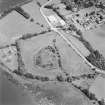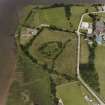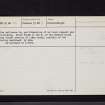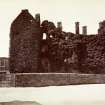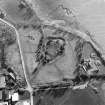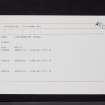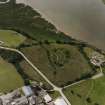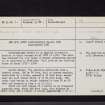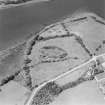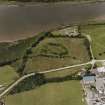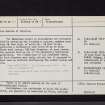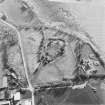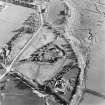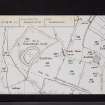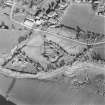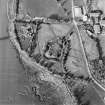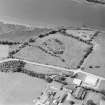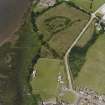Kirkcudbright Castle
Castle (Medieval), Earthwork(S) (Period Unassigned), Core (Flint)(Neolithic) - (Bronze Age)
Site Name Kirkcudbright Castle
Classification Castle (Medieval), Earthwork(S) (Period Unassigned), Core (Flint)(Neolithic) - (Bronze Age)
Alternative Name(s) Castle Dikes; Castledykes
Canmore ID 64063
Site Number NX65SE 26
NGR NX 6771 5088
Datum OSGB36 - NGR
Permalink http://canmore.org.uk/site/64063
- Council Dumfries And Galloway
- Parish Kirkcudbright
- Former Region Dumfries And Galloway
- Former District Stewartry
- Former County Kirkcudbrightshire
NX65SE 26 6771 5088.
(NX 6771 5088) Kirkcudbright Castle (NR) Castledykes (NR)
OS 6" map (1938)
Kirkcudbright Castle is an English foundation datable to their occupation of 1288 to 1312. The site has produced the only piece of French polychrome pottery to be recovered in Scotland. This pottery has limiting dates of about 1275 - 1300.
S Cruden 1960
Castle Dikes: The existing earthworks form a central mound, 196 by 80 feet, with an uneven surface, surrounded by a ditch, generally 30 feet deep, except near the east corner where it is 20 feet deep. The outer bank varies in height internally from 16 to 25 feet and externally from 4 to 12 feet.
There are some traces of a bailey in an irregular squarish area, about 450 feet long, with ditches on each side, and a number of mounds suggesting the remains of ramparts.
F R Coles 1891
The Edwardian castle at Castledykes was excavated 1911-13 revealing the foundation courses, nowhere more than 2 1/2 feet high, of walls 9 1/2 - 7 1/2 feet thick, enclosing a rectangular area about 95 by 55 feet. There were towers, 36 1/2 feet diameter, at each corner, the eastern forming one of the externally buttressed gatetowers. The foundations of the southwest tower, 44 feet diameter were badly robbed, but it appeared to have been an addition buttressing the corner inside and out.
J Robison 1914; 1926; G C Dunning, H W M Hodges and E M Jope 1960
There is no extant masonry at the site of Kirkcudbright Castle. Castledykes, the earthworks on which the castle stood, are generally as described by Coles, although the reference to, and dimensions of an inner rampart are confusing. About 70.0m to the N of the central mound are slight remains of outer works, possibly of the bailey mentioned by him.
Re-surveyed at 1/2500.
Visited by OS (EGC) 10 February 1965
Motte.
Information from E J Talbot Mottes TS.
NX 677 508 In April 2002 archaeological monitoring of civil engineering test pits and boreholes was undertaken in advance of a proposed expansion of the sewage works at Kirkcudbright, which is located immediately to the NW of the Scheduled remains of the 13th-century castle known as 'Castledykes'.
A total of nine machine-excavated trial pits were dug to a depth of 3.0-3.5m below the surface, and four boreholes were sunk to a depth of 15m below the surface. No archaeological features or recognisable archaeological stratigraphy were encountered.
Full report deposited in Dumfries and Galloway SMR and the NMRS.
Sponsor: West of Scotland Water.
M L Brann 2002
Publication Account (1978)
The first mention of a castle of Kirkcudbright was in 1290 when John Baliol was noted to be the custos of that castle (ER, i, 39). This castle was probably the structure erected on Castledykes, one quarter of a mile to the southwest of the burgh on the left bank of the River Dee. The earthwork is massive, measuring 200 feet (6lm) by 100 feet (30. 5m) within a ditch which averages fifty feet (17m) in width and nine feet (2.74m) in depth (RCAHM, 1914, 143-4). Excavations carried out on the site in 1911, 1912 and 1913 revealed a south, east and north tower, as well as a gate-house entrance, and a west curtain wall (Robison, 1926, 74). Pottery from Gascony was uncovered (Dunning et al . , 1957-8, 120 as well as the remains of a midden, a bone comb and horseshoe (Robison, 1926, 74). The castle of Kirkcudbright was included in a grant of the lordship of Galloway to Edward Bruce, brother of the king, in the early fourteenth century, but virtually nothing was heard of the castle after that date (Robison, 1926, 62).
Information from ‘Historic Kirkcudbright: The Archaeological Implications of Development’ (1978).
Publication Account (1986)
What was once a royal castle now survives as enigmatic humps and hollows in a flat riverside fIeld a short distance downstream from Kirkcudbright. On closer examination these remains reveal themselves to be the foundations of a stone-built stronghold of some magnitude. Excavation in 1911-13 showed that within a surrounding ditch, originally a wet moat, were the walls of a courtyard castle with a double-towered gatehouse facing north-east. Unusually, the gatehouse towers were buttressed. The curtain walls had had rounded towers at the angles, including a larger donjon at the south-west The finds were particularly rich in pottery and ironwork, including eight imported French jugs (Stewartry Museum).
The castle first appears on record in 1288, held by one of the four Guardians of the realm. Although the layout is reminiscent of an 'Edwardian' castle, there is no evidence that Edward I of England had a direct hand in its construction. However, he did stay here for a few days in July 1300, and it appears as an English supply-base until 1306-7. Little is known of its history during Douglas ownership. It may have served as a refuge for Henry VI of England after the Battle of Towton in 1461, and was probably last used as a residence by James IV on journeys to and from Whithom. In 1509 possession of the castle lands passed to the burgh.
Information from ‘Exploring Scotland’s Heritage: Dumfries and Galloway’, (1986).
Test Pit Survey (11 January 2019 - 5 November 2019)
The test pitting undertaken at the site of Castledykes recovered a number of artefacts which contribute to our understanding of the history of the site. The majority of the finds span from the medieval period through to the 20th century. The medieval finds comprise pottery sherds which appear to be of local manufacture and draw parallels with pottery found in the earlier excavations as well as at Whithorn and Caerlaverock. From the work at Caerlaverock, this pottery form was identified as dating from the 1220s to the 1270s, suggesting that the origins of the castle at Castledykes could have potentially earlier origins than the initial date of 1288 given by the documentary sources. The presence of smithing slag and large amounts of fuel ash slag also suggests that small-scale smithing may have taken place, although whether this was contemporary with the castle remains uncertain. The next period that is well-represented is the late 17th-20th century where a number of pottery sherds, glass vessels and small objects appear to represent domestic items discarded during the area's use as recreational ground in this period. The presence of window glass and roofing slate, however, points to the area being used for dumping until the 20th century. Outwith these main phases, a single find of a flint core platform was discovered which dates from the Neolithic or Bronze Age, further adding to the growing assemblage of prehistoric finds from the Kirkcudbright area. No archaeological features were identified within the test pits but the array of artefacts recovered hints at the potential that this area holds for future works. The works also allowed volunteers to further their knowledge of the history of this important site, and gain experience in the different techniques involved during an archaeological investigation.
Information from OASIS ID: rathmell1-326797 (C Williamson) 2019



























